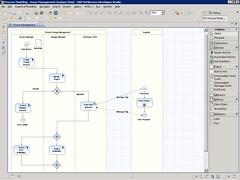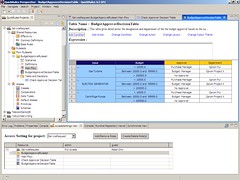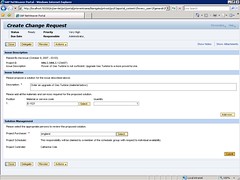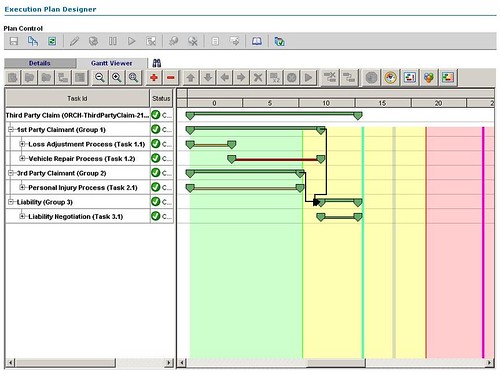It was a busy week last week at TUCON and I completely forgot about the questions from the Business Rules Forum Q&A from the webinar that I did on the 24th. I’m not sure if the replay is available yet, I’ll post a link when I hear about it.
Here’s my answers to the questions that came up during the presentation, although I responded to some of these at the end. Where the question wasn’t clear, I took a stab at an interpretation; if I missed the point, please add a comment to this post with your clarification and I’ll follow up.
Explain the relationship between business models and BPM.
Not sure of the exact intent, but I think that this is asking about the relationship between business (process?) modeling and BPM. Business models of various sorts, including business process models, are often created by an organization to provide a high-level, business-oriented view of their operation. From an enterprise architecture standpoint, these are the models in the highest level of the architecture that may be created by, and are always understandable by, a non-technical business analyst. In the case of business process models, these are created to model the flow of a business process, usually in a flow-chart or swimlane type of diagram. In many cases, these are created in a standalone modeling tool — either a simple desktop application like Microsoft Visio, or a more comprehensive tool such as IDS Scheer’s ARIS — but may also be modeled directly in the process modeling environment of a BPM suite (BPMS). In this latter case, a process model can be directly translated to an executable process.
Is there any benefit to implementing a BRM without a BPM?
Yes, there are many cases of using a BRMS separately from BPMS: the rules/decisions may be accessed directly as part of a manual process, where a user enters in the required parameters and is given a decision back in return, or they may be called from other applications such as a CRM.
Please mention vendors or products by name, even if caveats apply.
and
Can you name products that support what has been presented?
and
What are the methods & technology tools used for BRM & BPM?
I can’t recall if we were talking about BPMS or BRMS vendors here, so I’ll try to cover both. To hit the major vendors, take a look at which ones are included in the reports by the big analysts. Gartner includes the following BPMS vendors in its Magic Quadrant for BPMS, published in December 2007: Adobe, Appian, Ascentn, AuraPortal, BEA, Captaris, EMC, Fujitsu, Global 360, IBM, Intalio, Lombardi, Metastorm, Microgen, Oracle, Pegasystems, Savvion, Singularity, Software AG, SunGard, TIBCO and Ultimus. Forrester splits up the market into four categories with several vendors in each, which I’ve listed in a previous post.
On the BRMS side, Forrester recently issued a report on BRMS vendors in which they evaluated CA, Corticon Technologies, Experian, Fair Isaac, Haley Limited, ILOG, Innovations Software Technology, InRule Technology, Intelligent Results, Pegasystems, and SAP.
There are other vendors of both types, but this covers the major players. Also notice that Pegasystems plays in both markets — and in fact is a leader in both — since its BPMS is based on a rules engine.
Who are some of the vendors with tight integration between BPM and BRM?
Pegasystems is the obvious starting point, since they use a rules engine as an underlying platform for their BPMS. Many BPMS vendors don’t want to talk about a tight integration with a third-party BRM since that implies a weakness in their own rules capabilities. All BPMS vendors, through their support for invoking web services, can integrate loosely with BRM.
In your opinion, have any BRMS suites achieved robust BPM capabilities?
Only Pegasystems, to my knowledge. It’s more likely that a BPMS will achieve BRM capabilities rather than the other way around, in my opinion.
How could you change a business rule and have it only affect new BPM processes and not in flight process instances?
There are two ways to do this. First, if all parameters that drive the rules are known at the beginning of the process, the process instance could invoke the rules immediately after it is created, and store the decision results until they are required; since the rules are executed at the time that the process instance is created, the instance will not be affected by any changes to rules while it is in progress. Second, a process can call a specific version of a rule, assuming that the BRMS supports rules versioning. That way, any process instances created from a specific version of a process definition can call a specific version of a rule, even if the rule has changed since then. Newer process definitions could be changed to call a later version of the rule.
You said that a BPMS will call a BRMS (typical scenarios). How would the BRMS know the scope of what needs to be checked? For example, if you have the rule "some applicant of each loan application must have a credit score of 600". When the business process for loan applications calls the BRMS, how does it determine the set of applicants that need to checked?
I think that the question is about where the BRMS gets its information that is used as parameters for the decisions. This would typically be passed to the BRMS from the calling application, in this case, the BPMS. The BPMS may need to make calls to other systems in order to get this information, then forward it to the BRMS: remember that part of the role of the BPMS is to orchestrate multiple systems and pass data along between them, including the BRMS.
Do you normally see that the same business users are maintaining both the processes and rules or are they normally different business users?
If you’re talking about the business analysts that would be designing the processes or rules, it is best if they are the same — so that they can decide what happens in a process versus what happens in a rule — but often are different people due to the training requirements. If these are separate roles, then the process analysts need to learn enough about rules to know when to request that a rule set be created for them to call from their processes.
How would you define the relationship between BPM, BRM and RBA (Run Book Automation)?
I’m not that familiar with RBA, but it is focused on IT and systems processes, not business processes. At TUCON last week, however, one of the presentations was on how they used TIBCO products for IT processes, although he didn’t refer to it as RBA.
Do you agree that BRM and BPM have to be married with the SME from the business side and the SME from the IT side to be successful?
I’m unclear on what this question means. "SME from the business side" means, to me, someone who is an expert on the business being performed; I’m not sure what "SME from the IT side" means. Both BRM and BPM are most successful when there is collaboration between business and IT: the business analysts doing the high-level modeling of the rules and processes to ensure that they meet the business requirements, and IT making sure that the technical underpinnings (such as calls to web services) are in place.
Do you have a list of feature set for BRM and BPM for product evaluation?
and
Could we get a list of recommended BPMS and Rules Management systems and why they are recommended?
Gartner and Forrester both publish comparative reports on BPMS and BRMS, I suggest that you start there.
What is the difference between BRM and procedures / governing document / policies? Give examples of BRM.
Policies, procedures and governing documents are the "rules" by which the business operates, but may not be automated in any way: many organizations just have people refer to a policies and procedures guide to tell them what to do in a manual process. BRM allows you to codify those policies and procedures so that they can be automated, and are executed the same way every time.
What about open source offerings? Have you worked or reviewed any of those?
Drools (from jboss) and NxBRE are two open source BRMS offerings. jBPM (also from jboss) and Intalio are both open source BPMS offerings. I recently did a review of Intalio but haven’t yet published what I saw; I haven’t worked with any of the other products. Many open source offerings don’t have the full functionality of their commercial counterparts so may not be included in the analysts’ comparative reports; the recent Gartner Magic Quadrant for BPMS is the first one in which Intalio has been included, for example.
Can you provide a simple example of how BPM and BRM are applied in practice?
A typical example that I’ve seen is in claims processing. There are many specific policies and procedures that must be followed to process a claim, and many BPM implementations just leave the decisions based on those policies to a person who is participating in the process: for example, give the work step to a person and have them decide the type of the claim and what region should be processing it. By adding BRM, these decisions can be automated based on data that is already known
Do you feel BPM can be used as a tool to integrate compliance management systems? e.g. OSH, Environment, Quality etc.
I’m not a compliance specialist, but I see many organizations using both BPM and BRM to help with their compliance efforts, since both can help to standardize processes and allow for easy auditing of what was actually done. As for integration with compliance management systems, that would depend on those systems and whether they provide a web services interface or other API.
What are some of the software packages you can purchase for extracting business rules?
The major BRMS products typically include tools for mining business rules from existing systems; you’ll need to check their functionality against the particular systems and platforms from which you want to extract rules to see if they’ll work for you.
How are the BRMS incorporated with any testing tools?
Many of the BRMS vendors have simulation and testing tools as part of their suite, specifically to test if the rules are complete and non-contradictory.




